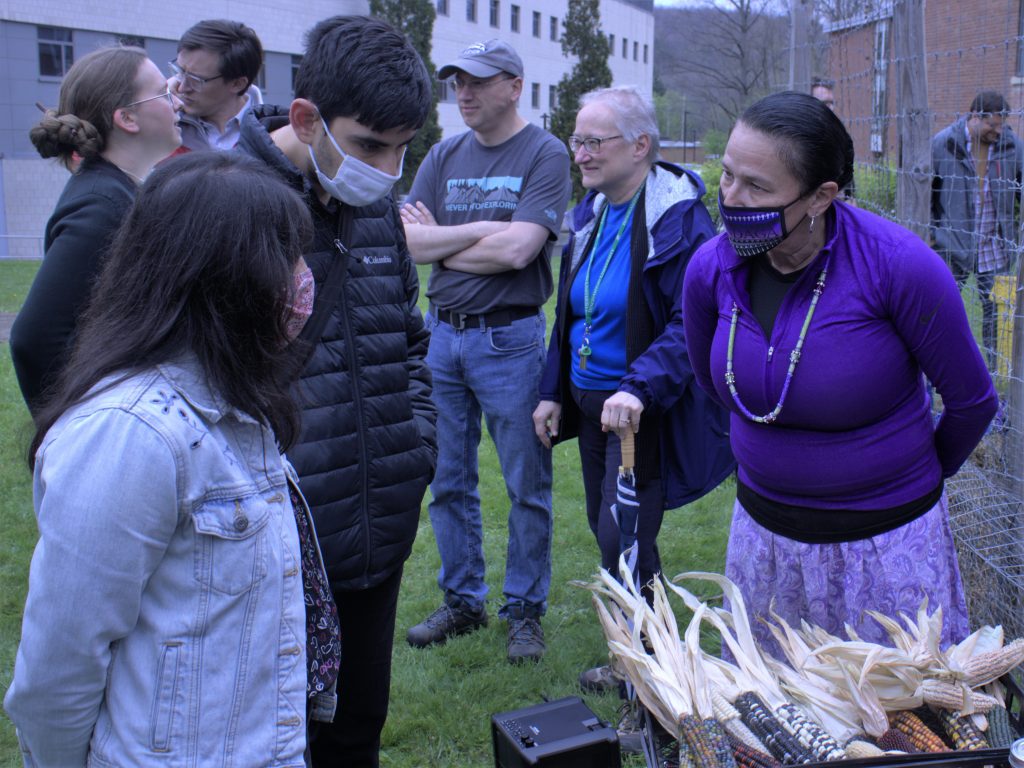On Wednesday, Binghamton University hosted a ceremonial planting of the Three Sisters in the Science I courtyard.
Several individuals spoke prior to the planting ceremony in a speaker series held in the Fine Arts Building. The series was hosted by BrieAnna Langlie, an assistant professor of anthropology, and Barrett Brenton, a faculty engagement associate in the Center for Civic Engagement, featuring visitors from the Haudenosaunee Confederacy. Around 100 people attended the event in-person, with others tuning in over Zoom. The “Three Sisters” are bean, squash and corn — all sacred to the Haudenosaunee, whom the event was meant to honor, according to Langlie.
“I really hope the lecture and panel on Wednesday, as well as the ceremonial planting, acknowledges in a formal way those who came before us on this land and the incredible ingenuity of their agricultural system,” Langlie said. “The Three Sisters are a part of their creation story, but more than that, as a scientist I recognize the brilliance of planting them together in biological symbiosis. They were some of the best scientists, the Haudenosaunee.”
Angela Ferguson, a traditional corn grower from the Onondaga Nation Farm and member of the Onondaga Nation Eel Clan, was the first speaker in the series. She described her life experiences, the meaning of land acknowledgements and retold the creation story of the Three Sisters. Ferguson used a can of Green Giant sweet corn to exemplify the disconnect that has developed between people and food, prompting laughter from the audience.
Sarah Patterson, of the Onondaga Nation Farm and a member of the Onondaga Nation Eel Clan, showed the audience an ear of grandfather corn — the corn that all corn varieties are derived from that strengthens any corn it’s grown with — during her talk, holding up the can and the cob for everyone to see.
“If it didn’t come out of the earth or it didn’t have a looking, breathing pulse, then don’t put it in your mouth,” Ferguson said. “That’s what an elder told me.”
After the speaker series, the event moved to the Science I courtyard where students and volunteers had already built the garden for the ceremonial planting. The ceremony included an Indigenous Thanksgiving blessing from a Faith Keeper and Fire Keeper of the Haudenosaunee Confederacy and a statement from Ferguson acknowledging that it has likely been 200 years since Indigenous seeds were planted in this soil. Langlie also thanked the collaborators who were involved in the event.
BU President Harvey Stenger began the ceremony by welcoming the Haudenosaunee Confederacy.
“What we’re doing here today is really something that’s been happening for almost forever,” Stenger said. “And we owe a lot of what we’re going to do today to the nations that lived here long before we came here. The planting of the three sisters — beans, squash [and] corn — is a tradition rooted in not only making sure the Earth is preserved, but also making sure that we are sustaining it, and that we eat and that we live. So it’s a very practical ceremony, as well. I’m proud that [BU] was chosen, selected and encouraged to bring our visitors down today to do this.”
Langlie expressed hope that the event will give momentum to the creation of a Native American and Indigenous Studies program and degree at BU.
“There is a Native American and Indigenous Studies Working Group that has been organized in a sort of grass roots manner by faculty,” Langlie wrote in an email. “We hope to establish a Native American and Indigenous Studies degree and program here on campus. Many of those faculty were in attendance today, and we hope this event inspired students, professors and administrators from across the University to see a program of this sort come to fruition in the future here at [BU].”
Chelsea Brothers, a freshman majoring in English, found the discussion about the connection between people and food interesting.
“They were truly inclusive and informative on the importance of land and that connection,” Brothers said. “I’ve realized I’m not as connected with my food, but they brought everyone in together to understand it better.”
Vincent Gatto, a senior majoring in anthropology who helped build the garden, said he was grateful for the garden and planting ceremony.
“I think it’s about time that our campus acknowledged the Haudenosaunee and I think I speak on behalf of all students that we should be honored and so thankful to have something like this on campus,” Gatto said. “That connection that’s been void for so long is finally back and will hopefully bring more love and what all gardens bring, happiness back to campus.”



